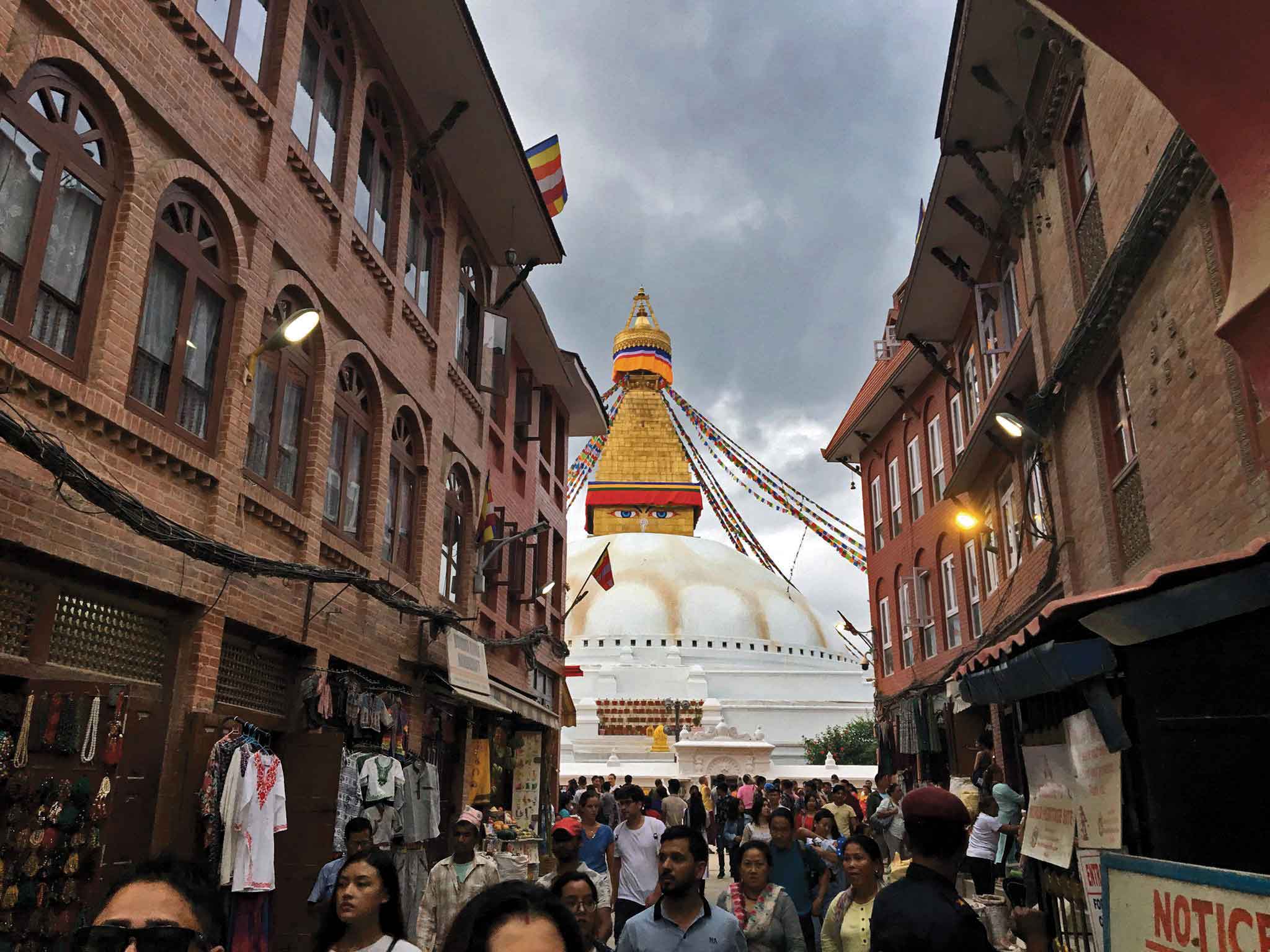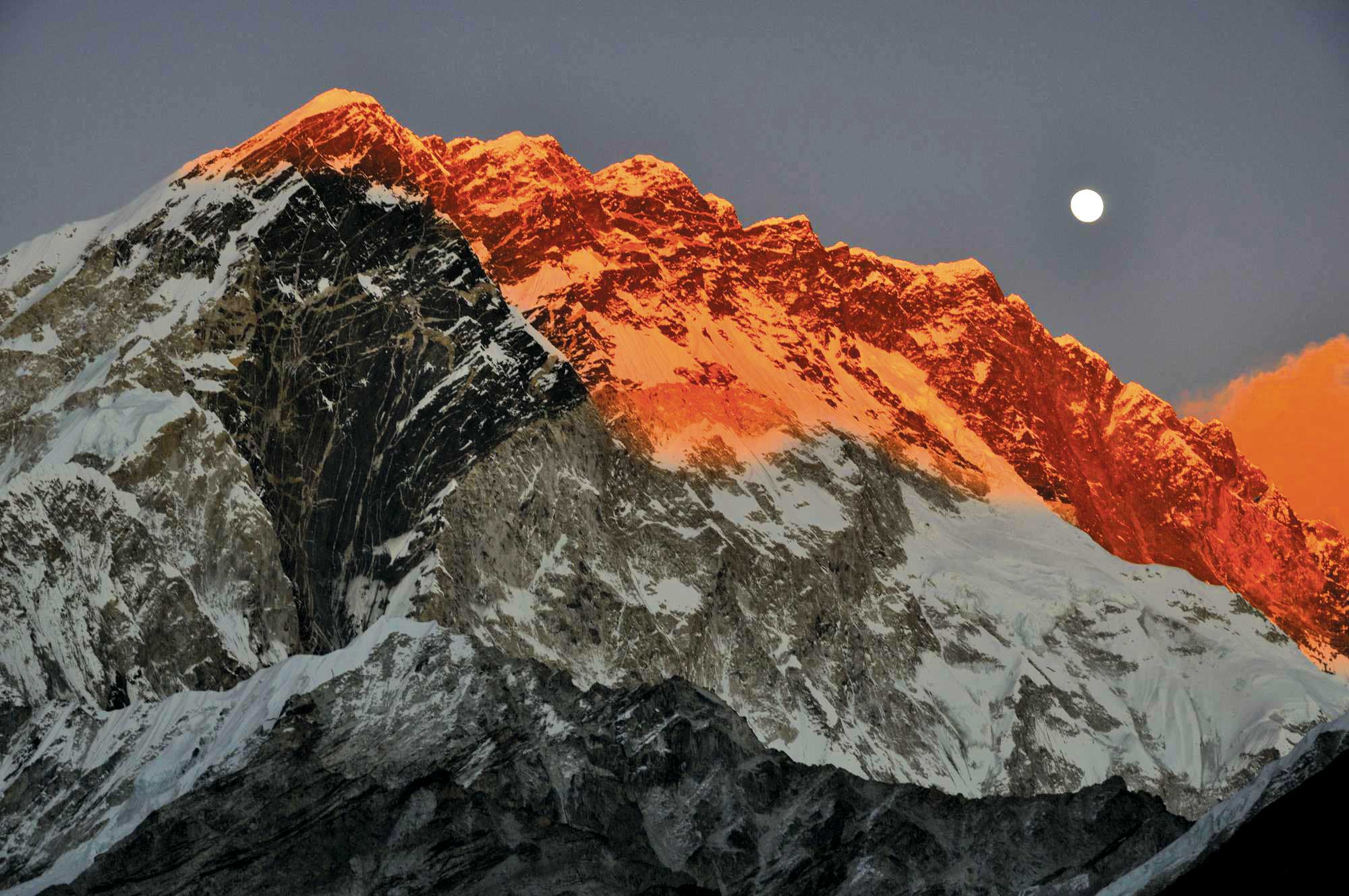Everest mystery: are Norgay and Hillary the first to ascend the highest peak of the world?

May 29, 1953. At about 11:30 in the morning, Edmund Hillary and Sherpa Tenzing Norgay stepped on the topmost point on Earth. Their stay of about a quarter of an hour on the slightly flat peak was spent in taking pictures.
After having taken some snaps of Tenzing on the peak, Hillary shook his head and declined to give the camera to Tenzing when he asked for it to capture some shots of him. Hillary didn’t wish to record the historical moment of reaching the summit for himself. One can understand that the camera, which had secured such a rare achievement, was worthy enough to be not risked at the hands of Tenzing, who was unaware of its functioning. Apart from it, Hillary took his time to observe the vicinities of the peak, especially beneath the North Col, as far as was visible.
 He was searching for something…but didn’t find his ‘object of quest’. However, the world was scintillated by the successful expedition of Edmund Hillary and Sherpa Tenzing Norgay. The two mountaineers became heroes of the world. But…was it that these two were the first to reach the peak, or were they the first to successfully reach and return? There were other questions, too. Who thought first that Everest could be scaled? Why to climb Everest, and what for?
He was searching for something…but didn’t find his ‘object of quest’. However, the world was scintillated by the successful expedition of Edmund Hillary and Sherpa Tenzing Norgay. The two mountaineers became heroes of the world. But…was it that these two were the first to reach the peak, or were they the first to successfully reach and return? There were other questions, too. Who thought first that Everest could be scaled? Why to climb Everest, and what for?
Till the end of the eighteenth century, it was not known which the highest peak in the world was, or where it was. It was then that British India initiated mapping of the entire Indian subcontinent. Being between two big nations, India and China, Nepal, which shared its borders with them, was naturally included as well.
The survey, which had defense and strategic purpose, came out with a rather unrelated and unexpected result. Amongst many snowy cliffs, Peak 15 turned out to be the highest in the world.
George Everest, Surveyor General of British India, confirmed its height in 1841. This was actually a new achievement for the world. Later, in 1865, Peak 15 was named after him, and became Mount Everest.
The British were proud of the record-breaking achievement from the survey. At the time, mountaineering in Europe was in its early stage, though it had already been decades of initiation. Hence, it was instinctive for the mountaineers to think of reaching the top of Everest. Clinton Thomas Dent, a British surgeon, was the first to think about scaling the peak. This British Alpinist writes in his book, ‘Above the Snowline’, about the possible scaling of Everest, and says, “Talking about scaling Everest now could be like swimming across the Niagara Falls in haste, and I won’t claim that it shall be wise to scale Everest now, but I believe it is possible for mankind, and we shall see it being successful in our own times.”

Dr. A.M. Kellas corroborated this thought of Dr. Dent in his study, ‘A Consideration of the Possibility of Ascending the Loftier Himalaya’, in 1916. He stated that the Himalayan peaks were possible to be scaled physiologically. British Alpinists were excited to measure the height of Everest after such a declaration from the expert mountaineer and surgeon. In 1919, the Mount Everest Committee was founded by Britain’s Alpine Club (the apex club for mountaineers), in collaboration with the Royal Geographical Society. Nepal hadn’t opened its doors for the world till then. Hence, on receiving permission from the Dalai Lama for entry into Tibet, a mountaineering campaign moved forward through Sikkim and Tibet. The prospective study of Everest-mountaineering, preview, and mapping were the purposes of this campaign.
 Among the nine selected for the pre-survey mountaineering group, there was one mountaineer who was about to establish a record in the history of mountaineering. He was George Herbert Leigh Mallory; in short, George Mallory. The son of a pastor of Cheshire in Britain, Mallory was a schoolteacher. He had an interest in mountaineering even while working in a public school in Winchester. He lived in Cambridge with his wife Ruth Turner and three children. With an impressive personality and well-built physique, he was admired by all. He was considered as the most experienced mountaineer of his generation, having already ascended many peaks in the Alps.
Among the nine selected for the pre-survey mountaineering group, there was one mountaineer who was about to establish a record in the history of mountaineering. He was George Herbert Leigh Mallory; in short, George Mallory. The son of a pastor of Cheshire in Britain, Mallory was a schoolteacher. He had an interest in mountaineering even while working in a public school in Winchester. He lived in Cambridge with his wife Ruth Turner and three children. With an impressive personality and well-built physique, he was admired by all. He was considered as the most experienced mountaineer of his generation, having already ascended many peaks in the Alps.
But, the matter was different about the Himalayas; the Everest base camp itself was higher than the highest peak, Mont Blanc, in the Alps. Therefore, the preparations for climbing the Alps was not sufficient for Everest, as it wasn’t known whether it was possible to survive without oxygen at a height of 29,000 feet. The human race was about to experience taking each step on the heights of the Himalayas for the first time.

May 18, 1921. The British Mount Everest Reconnaissance Expedition started from Darjeeling. In order to acquire extensive information on Everest, hundreds of porters, cooks, and yak-herders were included in the expedition to support the mountaineers under the leadership of Colonel Charles Kenneth Howard Bury. The Tibetans were gleeful to see such a unique caravan, as this kind of gathering was happening for the first time in their region. On September 23, Mallory reached the North Col, at 23,030 feet. He gathered information on the conditions of weather and snow at different heights. He even discovered the north and north-east faces, and possible routes to reach the peak. This pioneering effort by mankind on the heights of Everest was considered to be a successful one.
 The 1922 British Mount Everest Expedition, under the leadership of General Charles G. Bruce, reached base camp before May 5. Mallory was attempting again, buoyed by his previous experience. The purpose, this time, was ascending only; they didn’t have the added responsibility to survey. The team proceeded forward along the route proposed by Mallory. On May 22, along with Mallory, Lieutenant Colonel Edward Lisle Strutt reached 26,800 feet in the northern ridge.
The 1922 British Mount Everest Expedition, under the leadership of General Charles G. Bruce, reached base camp before May 5. Mallory was attempting again, buoyed by his previous experience. The purpose, this time, was ascending only; they didn’t have the added responsibility to survey. The team proceeded forward along the route proposed by Mallory. On May 22, along with Mallory, Lieutenant Colonel Edward Lisle Strutt reached 26,800 feet in the northern ridge.
It was the first time ever that human beings had ever reached this height. On May 23, George Finch and Geoffrey Bruce of the same team reached a height of 27,300 feet, using oxygen. This, too, was for the first time. New records were being made. However, after the death of seven porters in an avalanche over North Col, the ascent was postponed in the final moments. Human casualty in big numbers, and the incurred fund-crisis, halted the ascent in 1923. Mallory, who had spent several months of the previous two years in the Himalayas, utilized the opportunity to visit New York. On March 18, 1923, his interview titled ‘Climbing Mount Everest is Work for Supermen’ was published in The New York Times.
He was asked, “Why did you want to climb Mount Everest?” “Because it’s there,” he replied, without elaborating further, although one could come to the following assumptions inherent in his succinct statement:
The belief that, as Everest was discovered by Britain, it had to be a British to climb it first.
The wish that Britain should set an example on mountaineering for the world.
It was also reflective of the experiences of the two previous ascents and a description of Mallory’s high ambition to reach the peak anyhow.
1924. The British Mount Everest Expedition is all set to go on the road again. Having reached close to the peak in 1922, they arrived with high expectations this time. The grandeur of the journey was the same; like some highly sophisticated army expedition. Only food that was fit for an officers’ mess, or a prosperous British household, was supplied. The fervor in the air was that, ‘nothing is impossible for us’. Mallory, who was the only one in the team continuously on all three occasions from 1921 to 1924, was included for the final attempt.
 After the positive results of using oxygen were seen in the experiment during the second ascent, Mallory was also preparing to reach the peak using oxygen this time. For this, Andrew Comin Irvine was included as the oxygen expert in the team. Sandy, to his friends, and an engineering student at Merton College, Oxford, Irving was only 22 years old. This was his first ascent on the Himalayas, and he had full confidence in Mallory’s experience.
After the positive results of using oxygen were seen in the experiment during the second ascent, Mallory was also preparing to reach the peak using oxygen this time. For this, Andrew Comin Irvine was included as the oxygen expert in the team. Sandy, to his friends, and an engineering student at Merton College, Oxford, Irving was only 22 years old. This was his first ascent on the Himalayas, and he had full confidence in Mallory’s experience.
But, the weather didn’t support after a few days. Due to heavy snowfall, the plan to reach the summit swiftly was getting unsuccessful. A porter and a Gurkha summiteer had already died while attempting to set a camp at 23,000 feet in the North Col. In this scenario, in order acclimatize to the Himalayan environment, after reaching Rongbuk Glacier twice, Mallory’s team decided to cross the Rongbuk Glacier in the third and final attempt, whatever the conditions.
After the insistence of the porters to return due to bad weather, Mallory was compelled to halt the ascent, planned with Geoffrey Bruce. On the other hand, team leader Colonel Norton was inflicted by snow-blindness when he took his goggles off, and his companion, Howard Somervell, almost died due to lack of oxygen. Their attempt failed, too.
Even after a series of failures, Mallory was firm in his decision to continue the ascent, even if oxygen had to be used. His judgment was that the two earlier attempts had failed due to the lack of oxygen. That was why he preferred to take oxygen expert Andrew Irvine, instead of Noel Odell, with him. Mallory wanted to reach the summit anyhow this time.
Mallory’s determination
It can be imagined how it would be to have an opportunity to be one among the first mountaineers to step on the summit of Everest. The limits of such an altitude were known to none; Mallory realized the thrill of every unknown step that he was taking uphill. After having reached the heights of discussion, due to the two previous attempts, and being the only one to be included in all three expeditions, he didn’t want to be devoid of the opportunity. Being the only mountaineer to have participated in three attempts, he felt that he should be the first to reach the summit, which was natural too.
He wanted to set a world record. Moreover, being 37 years old already, it was almost certain that he wouldn’t be selected for the next expedition. There was another reason, too–while on his third expedition, he had promised his beloved wife Ruth that he would leave her photo on the summit.
Because of all these reasons, Mallory’s mind was not able to accept the uncomfortable circumstances; his desire was dominant everywhere.
June 6, 1924. In the morning, Mallory and Irvine bid goodbye to Noel Odell, before ascending from Camp 4 at North Col. Odell takes their picture. This becomes the final picture of Mallory
and Irvine.
June 7, 1924. Odell receives Mallory’s message sent with one of his porters; they have already reached 2,000 feet below
the summit.
June 8, 1924. Odell, too, climbs uphill in the morning. After a few hours, with the clouds interrupting his vision time and again, he spots Mallory and Irvine at a distance of less than a mile. They are climbing, one after another, towards a prominent rock-step in the final peak. Then, the weather changes suddenly. A big chunk of cloud forms a wall between Odell and them. After some time, the cloud disappears. Heading towards the peak, Mallory and Irvine disappear, too.
Odell ascends in search of Mallory and Irvine, as the wind keeps blowing, and it keeps snowing, but all is in vain. As per Mallory’s pre-instructions, Odell returns to Camp 4 that night. For two more days, Odell climbs uphill to find the whereabouts of his colleagues, but neither Mallory nor Irvine is to be found.
Odell waits for his colleagues at a height of 23,000 feet, but seeing no sign of them, he returns. The team decides that there is no reason to search anymore, as George Mallory and Andrew Irvine are assumed to be dead. After the death of four members of the expedition, team leader Colonel Norton is not prepared to take any more risks. Along with the loss of Mallory and Irvine, 13 people had died so far in the three mountaineering expeditions, altogether. The whole of Britain was shocked at the news of the death of Mallory and Irvine. Britain mourned their death nationwide; the British king sent a condolence message to the families of the mountaineers. The struggle by Mallory and Irvine to reach the highest point on Earth had made them global heroes, and after the end of the World War, the world diverted its attention from war to Mallory and Irvine again. But, the question remained
the same…

Did they reach the summit?
If one is to believe in Mallory’s strong determination and will power, it is considered as logical that he was successful. Apart from it, he had promised his wife to leave her picture on the summit. When in 1999, Conrad Anker, team-member of the Mallory and Irvine Research Expedition, found the dead body of Mallory, Ruth’s picture was not there. Had he possibly returned, leaving it on the summit? Likewise, for his colleagues, who were loyal towards Mallory, there was never any doubt of him not reaching the summit. Tom Longstaff, an explorer who was with Mallory in the 1922 expedition, declared, “Any mountaineer can reach the summit. It cannot be expected that the duo decided to return without reaching
the summit.”
Twenty-nine years after Mallory and Irvine vanished on Everest, when, on May 29, 1953, Hillary reached the summit with Tenzing, he was searching for the answer to the same question. Hence, as proof of reaching the summit, he only took Tenzing’s photo, spending more time trying to find any proof of whether Mallory and Irvine had reached the summit. Before starting on the expedition, Hillary had gathered ample information on Mallory.
After returning from the expedition, he said, “In reality, Mallory had maintained a different kind of relationship with Everest. He believed Everest to be close to him, and his eagerness to reach its summit had been increasing.” He imagined that, “If it was proved that Mallory and Irvine had stepped on the summit, it would be a reward of their consistent efforts.” He also stated that the inspiring character of Mallory had not only affected his team, but also the entire world. Hillary’s opinion was that they must have been successful in reaching the summit.
After 75 years, when Mallory’s body was found on Everest in 1999, it was expected that the mystery of whether he had reached the summit would be solved, but it didn’t turn out to be the case. The story of the Mallory-Irvine expedition has still been preserved as a mystery by Everest for years to come. But, the known fact is that George Mallory, who was found, and Andrew Irvine, who wasn’t, are still in their deep slumber in that infinite sea of snow.
Who knows, someday, along with Mallory’s lost camera, Irvine may be found in some corner in the snow. Let’s hope that, someday, this question sparks in some new mountaineer the thought and passion to do something different, and the mystery of whether they reached the summit or not gets solved.











